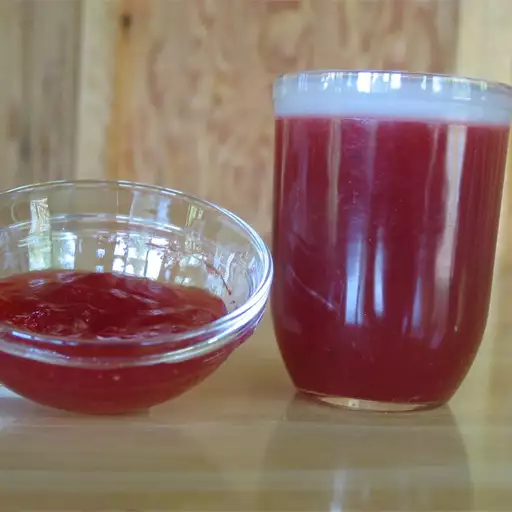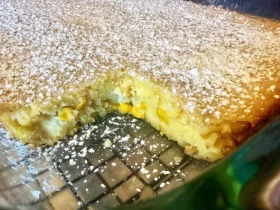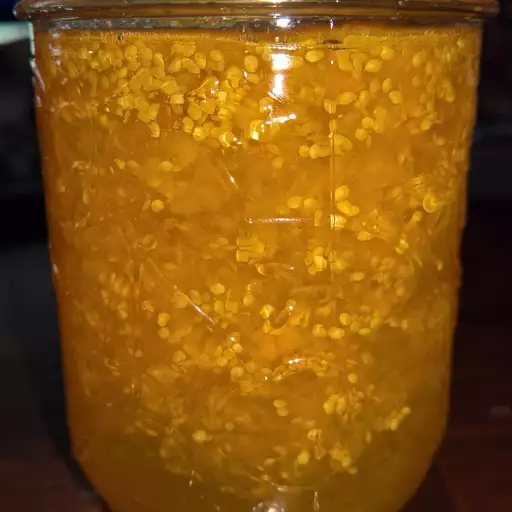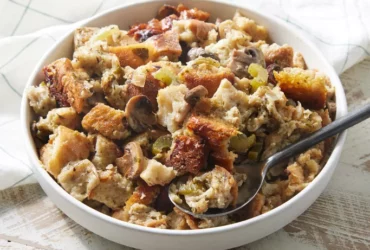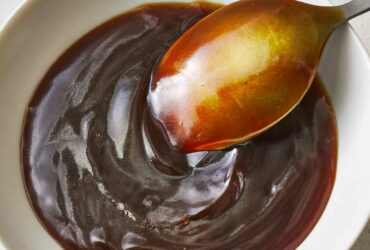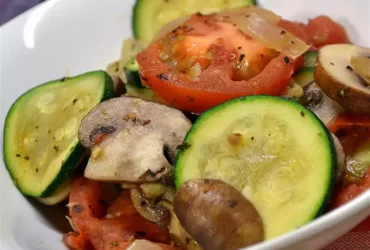Ingredients
Gooseberries
The process of making Gooseberry Jam begins with gathering a sufficient quantity of fresh gooseberries, typically between 2 and 3 pounds for an average-sized batch.
The quality of the gooseberries is paramount, as they should be plump, firm, and free from any signs of spoilage or blemishes. It’s also essential to note that different types of gooseberries may have varying levels of sweetness, acidity, and texture.
Rinse the gooseberries gently in cold water to remove any dirt, leaves, or stems, then pat them dry with a clean towel to prevent excess moisture from interfering with the jam-making process.
Crush the gooseberries using a potato masher, fork, or fruit press to release their juice and pulp. Some recipes may call for cooking the gooseberries in water before crushing them, while others may require the use of a blender or food processor to break down the fruit.
Mix the crushed gooseberries with an equal amount of granulated sugar, such as sucrose or high-fructose corn syrup, in a large saucepan. The sugar helps to balance out the tartness of the gooseberries and contributes to the jam’s overall flavor profile.
Add a pinch of salt, usually about 1/4 teaspoon for each cup of sugar used, to enhance the flavor of the jam. Some recipes may also call for the addition of spices like cinnamon or ginger to add depth and warmth to the gooseberry jam.
Cook the gooseberry mixture over medium heat, stirring occasionally, until it reaches a gel point, usually around 215°F (102°C). This process can take anywhere from 20-30 minutes, depending on the size of your batch and the desired consistency.
Once the jam has reached its target temperature and viscosity, remove it from the heat source and let it cool slightly before transferring it to a clean glass jar. Store the gooseberry jam in an airtight container in the refrigerator for up to 6 months or freeze it for longer-term storage.
It’s worth noting that making homemade jam can be a trial-and-error process, as the results may vary depending on factors like the quality of the gooseberries, the ratio of sugar to fruit, and the desired consistency. However, with practice and patience, you can create a delicious and unique batch of gooseberry jam that’s tailored to your tastes.
Fresh or frozen gooseberries will work for this recipe, as stated by the USDA (United States Department of Agriculture).
Fresh or frozen gooseberries are the primary ingredients required for this recipe, and it’s essential to note that both options can be used depending on what’s available locally and seasonally. According to the USDA (United States Department of Agriculture), fresh gooseberries have a high water content and a tart flavor, making them ideal for jam production. Frozen gooseberries, on the other hand, are often blanched or flash-frozen to preserve their flavor and texture.
Here’s a list of the ingredients you’ll need:
- Gooseberries: Fresh or frozen (2 cups)
- Sugar: Granulated sugar (2 cups)
- Water: Water (1/4 cup)
- Pectin: Certo liquid pectin (1 envelope, or 0.25 oz)
Optional flavorings:
- Lemon juice (2 tablespoons)
- Vanilla extract (1/4 teaspoon)
The USDA recommends using fresh gooseberries as they are higher in pectin and easier to work with, especially if you’re a beginner. However, frozen gooseberries can be used if that’s all you have available. It’s essential to wash the berries thoroughly and remove any stems or leaves before using them.
Sugar and Pectin
When it comes to making gooseberry jam, two crucial ingredients play a significant role in achieving the perfect consistency and flavor: sugar and pectin.
Pectin is a naturally occurring carbohydrate found in the cell walls of fruits, particularly in the skins and cores. It acts as a gelling agent, thickening the jam and giving it a smooth, spreadable texture.
The type and amount of pectin used can greatly impact the final product’s consistency. High-methoxyl pectins are commonly used in commercial jam production, but they can be expensive for home cooks. Low-methoxyl pectins, on the other hand, are more readily available and often preferred by amateur jam makers.
Sugar serves multiple purposes in gooseberry jam: it helps to balance out the tart flavor of the fruit, provides a sweet and sticky texture, and acts as an antioxidant, preserving the jam’s quality and shelf life. The ideal sugar-to-fruit ratio is crucial for achieving the right balance between sweetness and tartness.
When using sugar, it’s essential to note that different types of sugar can affect the flavor and texture of the jam. Granulated sugar, for example, dissolves quickly and produces a smooth consistency, while brown sugar adds a rich, caramel-like flavor.
In traditional gooseberry jam recipes, a combination of granulated and brown sugars is often used to achieve the perfect balance between sweetness and flavor. However, some cooks may prefer using alternative sweeteners like honey or maple syrup for a more natural taste.
A standard ratio is 1:1 of sugar to pectin; however, some sources, such as Cornell University’s cooperative extension, suggest a range of 1020% pectin.
The ingredients required for making gooseberry jam are simple yet essential. Here’s a breakdown of what you’ll need:
Main Ingredients
- 2 pounds of fresh or frozen gooseberries
- 1 cup of granulated sugar (you can adjust the amount based on your desired level of sweetness)
Pectin and Sweetener
- Certo Liquid Pectin: This is a commercial pectin product that’s widely available in most supermarkets or online. It’s a convenient option, but you can also use homemade pectin from fresh fruit.
Optional Ingredients
- Lemon juice: Add a squeeze of lemon to balance the flavor and enhance the color of your jam.
- Spices: Try adding a pinch of ground cinnamon, nutmeg, or ginger to give your gooseberry jam an extra boost of flavor.
A standard ratio for sugar to pectin in most recipes is 1:1; however, some sources suggest a range of 10-20% pectin. This means you can adjust the amount of pectin according to your desired level of thickness and consistency. For example:
Pectin Ratios
- For a firmer jam, use 1/4 teaspoon of pectin per cup of sugar.
- For a softer jam, use 2-3 tablespoons of pectin per cup of sugar.
Cornell University’s cooperative extension suggests using a range of 10-20% pectin, which translates to:
Lower Pectin Ratio
- 10% pectin: 0.5 teaspoons per cup of sugar.
Higher Pectin Ratio
- 20% pectin: 1 teaspoon per cup of sugar.
Remember, the key is to adjust the amount of pectin according to your desired level of thickness and consistency. Experiment with different ratios to find the perfect balance for your gooseberry jam recipe!
Spices and Acidic Ingredients
The art of crafting delicious gooseberry jam lies not only in its preparation but also in understanding the fundamental ingredients, spices, and acidic components that make it a culinary delight.
Let’s begin with the main ingredients:
- For this recipe, you will need 2 cups of fresh or frozen gooseberries. The tartness and sweetness of these berries are essential to creating a balanced jam. Be sure to choose berries that are plump, yet firm, as they will be easier to cook down.
Next, you’ll need the sweetening agents:
- Granulated sugar is the most common choice for gooseberry jam, as it provides a solid foundation of sweetness while allowing the tartness of the gooseberries to shine. You will typically use 1 cup of granulated sugar for every 2 cups of gooseberries.
- You may also consider adding other sweeteners like honey or maple syrup to create a more complex flavor profile.
For spices, you can use either whole spices or ground spices:
- Cinnamon is a classic pairing with gooseberries, as it adds warmth and depth to the jam. Use 1/4 teaspoon of ground cinnamon per 2 cups of gooseberries for an authentic taste.
- Nutmeg is another common spice used in jam recipes. Its slightly sweet and nutty flavor complements the tartness of the gooseberries perfectly. Add 1/8 teaspoon of ground nutmeg to create a balanced blend.
Now, let’s move on to acidic ingredients:
- Lemon juice or vinegar is often added to jam recipes to enhance the flavors and preserve the jam. You will typically use 2 tablespoons of lemon juice per 2 cups of gooseberries for this recipe. Adjust the amount according to your desired level of tartness.
- The acidity in lemon juice also serves as a natural preservative, allowing your homemade jam to remain fresh for longer periods.
Citric acid or lemon juice can be used to balance the sweetness, while cinnamon and other spices add flavor.
- The key to a well-balanced gooseberry jam recipe lies in its ingredients and the judicious use of acidity and spice.
- Citric acid or lemon juice can be used to achieve this balance, as they help to cut through the sweetness of the fruit and create a tangy, refreshing flavor profile.
- The addition of citric acid is particularly useful when working with gooseberries, which have a naturally high sugar content that can make them difficult to pair with other ingredients.
- However, for those who prefer a more natural approach, lemon juice can be used as a substitute for citric acid.
- Lemon juice brings not only acidity but also a subtle citrus flavor that complements the sweetness of the gooseberries without overpowering it.
- Cinnamon and other spices are also essential components in balancing the flavors in a gooseberry jam recipe.
- Cinnamon adds warmth and depth to the jam, while its sweet, spicy flavor helps to round out the taste of the fruit.
- Other spices like ginger, nutmeg, or cardamom can be used in combination with cinnamon to create a unique and complex flavor profile that suits personal taste preferences.
- The amount and type of spice used will ultimately depend on individual preferences and regional traditions, but the general principle remains the same: spices should complement and balance out the sweetness of the gooseberries without overpowering them.
Preparation
Cleaning and Preparation of Gooseberries
To prepare gooseberries for jam-making, it’s essential to start with clean and properly cleaned fruit.
Here’s a step-by-step guide on how to clean and prepare gooseberries:
Cleaning Gooseberries
- Select fresh, firm gooseberries with no signs of mold or rot.
- Rinse the gooseberries thoroughly under cold running water to remove any dirt, debris, or insects.
- Pat dry the gooseberries gently with a clean towel or paper towels to prevent bacterial growth and spoilage.
Preparing Gooseberries for Jam-Making
- Cut off any stems or leaves, as they can impart bitterness to the jam.
- Wash the gooseberries again in cold water to remove any remaining dirt or debris.
- Remove the skins of the gooseberries by gently pressing them between your fingers. This will help release the natural pectin and make the jam-making process easier.
- Discard the skins and reserve the flesh for use in the jam recipe.
Packaging Prepared Gooseberries for Storage
- Transfer the prepared gooseberries to an airtight container or ziplock bag.
- Label and date the container, and store it in the refrigerator at 40°F (4°C) or below.
It’s essential to prepare your gooseberries correctly before using them for jam-making. This will ensure that your final product is safe to eat and has the best possible flavor and texture.
Rinse the gooseberries under cold water, then remove any stems or leaves.
Before you start preparing the gooseberries for jam-making, it’s essential to ensure that they are clean and free from any debris or contaminants.
Rinse the gooseberries under cold running water to remove any dirt, dust, or other impurities that may be clinging to them. This is a crucial step in preventing any unwanted flavors or textures from affecting the final product of your jam.
Next, carefully inspect each gooseberry and remove any stems or leaves that might still be attached. You can use a pair of tweezers or simply pinch off the stem with your fingers, depending on how delicate the fruit is.
Once you’ve removed all the stems and leaves, pat the gooseberries dry with a clean paper towel to remove excess moisture. This step will help prevent any mold or bacterial growth during the cooking process.
After rinsing and drying the gooseberries, they are now ready for chopping or crushing as required by your specific jam recipe. Make sure to use a gentle touch when handling the fruit to avoid bruising or damaging it.
Mashing and Cooking the Gooseberries
To prepare the gooseberries for jam-making, start by sorting through the berries and removing any that are rotten or damaged.
Select firm, plump, and fresh-looking berries with a bright green or light yellow skin, as these will be more flavorful and hold their texture better during cooking.
Next, wash the gooseberries thoroughly under cold running water to remove any dirt, debris, or pesticide residue that may be present on the surface.
Carefully pat the berries dry with a clean towel or paper towels to prevent excess moisture from affecting the jam’s consistency and texture during cooking.
Now it’s time to prepare the gooseberries for mashing. Remove the green leaves and calyxes, leaving only the edible fruit behind.
Rinse the gooseberries again if necessary, then mash them using a potato masher or a fork to release their juices and create a puree-like consistency.
Strain the mixture through a fine-mesh sieve or cheesecloth into a clean bowl to remove any seeds, pulp, or fibers that may be left behind during mashing.
To cook the gooseberry puree, combine it with an equal amount of granulated sugar in a medium saucepan. For example, if you have 1 cup of gooseberry puree, add 1 cup of sugar to the pot.
Add a pinch of salt to balance out the sweetness and enhance the flavors of the jam.
Heat the mixture over medium heat, stirring occasionally with a silicone spatula or wooden spoon to prevent scorching or sticking.
As the mixture cooks, it will start to thicken and reduce in volume. Stir more frequently as it approaches its desired consistency.
After about 20-25 minutes of cooking time, the jam should have thickened to your liking. To test its readiness, place a small amount on a chilled plate or spoon and allow it to cool to room temperature.
If the jam has set properly, it will maintain its shape when cooled. If not, continue cooking for another 5-10 minutes and testing again until it reaches the desired consistency.
Mash the gooseberries using a potato masher or your hands to release their juices.
To prepare the gooseberries for making jam, it’s essential to first extract as much juice and pulp as possible from the fruit.
Mash the gooseberries using a potato masher or your hands to release their juices. This process helps to break down the cell walls of the berries and releases the natural pectins, which are responsible for thickening the jam.
Using a potato masher is often easier than using your hands, especially if you’re working with a large quantity of gooseberries. However, if you don’t have a potato masher, simply crushing the gooseberries with your hands will achieve the same result.
The goal is to crush about half of the berries at first and then go back through and mash the remaining ones. This two-step process helps to evenly distribute the juices and pulp throughout the mixture.
As you mash the gooseberries, be sure to scrape the sides and bottom of the bowl regularly to ensure everything gets incorporated into the mixture. You can also use a spatula or spoon to help break down any remaining berry pieces.
Once you’ve mashed the majority of the berries, give the mixture a good stir to distribute the juices and pulp evenly. This is an essential step in preparing the gooseberries for cooking them down into jam.
Adding Sugar, Pectin, and Acidic Ingredients
To make delicious gooseberry jam, it’s crucial to start with proper preparation of the ingredients and equipment. Begin by washing the gooseberries thoroughly, removing any stems or leaves that may be present. Pat the berries dry with a clean towel to remove excess moisture.
Next, prepare the cooking equipment by combining the gooseberries with granulated sugar in a large saucepan. The general rule of thumb for jam-making is to use 3-4 parts sugar to every 1 part fruit. For example, if you’re using 2 cups of gooseberries, add approximately 6-8 cups of sugar.
Now that the sugar has been added, it’s time to introduce pectin. Pectin is a natural occurring substance found in the cell walls of fruits like gooseberries, apples, and berries. It helps to thicken the jam and create its characteristic gel-like texture. If you’re using commercial pectin, follow the manufacturer’s instructions for the correct amount to add. Typically, it’s 1-2 tablespoons per cup of fruit.
Acidic ingredients are also essential in creating the right balance for your gooseberry jam. Lemons or limes are commonly used to provide the necessary acidity, and you’ll typically need about half a lemon or lime, juiced, per cup of fruit. Be cautious not to add too much acid, as it can affect the flavor and texture.
Now that all the ingredients have been prepared and added to the saucepan, heat the mixture over medium heat, stirring frequently until the sugar has dissolved. Continue cooking the jam at a rolling boil, or 212°F (100°C), for about 20-30 minutes, or until it reaches your desired consistency.
Add sugar and pectin according to your desired ratio, along with any spices or acidic ingredients.
In this step, you will need to add sugar and pectin according to your desired ratio, along with any spices or acidic ingredients to create the perfect gooseberry jam.
To start, combine 2 cups of fresh or frozen gooseberries with 1 cup of granulated sugar in a medium saucepan. The amount of sugar you use will depend on how sweet you like your jam, but a good starting point is to use equal parts fruit to sugar.
Next, add the recommended amount of pectin to your mixture. Pectin is a natural occurring substance found in the cell walls of fruit that acts as a gelling agent when mixed with sugar and acid. You can buy pectin powder or liquid at most grocery stores or online.
The general ratio for making jam is 1 cup of sugar to 1/4 cup of pectin, but you may need more or less depending on the type of pectin you use and your personal preference.
Additionally, you can add spices such as cinnamon, nutmeg, or ginger to give your gooseberry jam a unique flavor. Start with a small amount and adjust to taste, as these spices can be quite potent.
Finally, add any acidic ingredients such as lemon juice or vinegar to balance out the sweetness of the sugar and pectin. A good starting point is to use 1-2 tablespoons of lemon juice per cup of fruit, but you can adjust this amount based on your personal taste preferences.
Once all the ingredients are combined, bring the mixture to a boil over high heat, stirring constantly. Reduce the heat to medium-low and simmer for 10-15 minutes, or until the jam has thickened and passed the “wrinkle test”.
Cooking and Bottling
Cooking the Jam
- To make this delightful Gooseberry Jam Recipe, you will need to start by cooking down the fresh gooseberries with some added sugar and water.
- The process begins by washing and preparing 2 lbs of gooseberries, removing any stems or leaves, and then chopping them into smaller pieces.
- Next, combine the chopped gooseberries in a large pot along with 1 cup of granulated sugar, 1/4 cup of water, and 1 tablespoon of freshly squeezed lemon juice.
- Cooking over medium heat, stir occasionally until the mixture reaches its soft-ball stage, or around 215-220°F (102-104°C), as indicated by a candy thermometer.
- Once the jam has reached the desired temperature and consistency, remove it from the heat source and carefully pour it into clean bottles while still hot.
- Leave about 1/4 inch of space at the top of each bottle before capping them securely with sterilized lids
- To ensure proper sterilization, you can submerge the filled bottles in a large pot of boiling water for 10-15 minutes.
- This method, known as bath canning, helps to kill any potential bacteria and extends the shelf life of your homemade jam.
Bring the mixture to a boil, then reduce heat and simmer for 1015 minutes or until the jam has thickened.
The process of cooking and bottling a gooseberry jam recipe requires attention to detail and patience, but the end result is well worth the effort. To start, combine 2 cups of fresh or frozen gooseberries, 1 cup of granulated sugar, and 1/4 cup of water in a large saucepan.
Place the saucepan over medium heat and stir the mixture until the sugar has dissolved. This should only take a few minutes, but be sure to stir constantly to prevent scorching.
Once the sugar has dissolved, increase the heat to high and bring the mixture to a boil. You will know it’s boiling when you see big bubbles rising to the surface of the saucepan. This is an important step in creating the perfect jam, as it helps to break down the fruit and create a smooth texture.
After the mixture has reached a boil, reduce the heat to medium-low and simmer for 10-15 minutes or until the jam has thickened. You can test the consistency of the jam by placing a small amount on a chilled plate. If it holds its shape and doesn’t run, it’s ready! If not, continue to simmer in short intervals, testing the jam each time, until you reach the desired consistency.
Once the jam has thickened, remove the saucepan from the heat and let it cool for a few minutes. This will help to prevent any further cooking or scorching of the jam. Then, carefully pour the jam into sterilized jars, leaving about 1/4 inch of headspace at the top.
Seal the jars tightly with clean lids and rings, making sure they are tight. You can store the sealed jars in a cool, dark place for up to 6 months. Before serving, simply screw off the lid and enjoy your delicious homemade gooseberry jam!
Remember to always follow safe canning practices when making and storing jams, jellies, or other preserves to ensure they remain fresh and safe to eat.
Bottling and Storage
The process of cooking and bottling a delicious gooseberry jam requires careful attention to detail, especially when it comes to storage.
First, it’s essential to cook the gooseberries until they’re soft and mushy, then mash them with a potato masher or blend them in a blender to create a smooth paste.
This mixture is often referred to as the “base” of the jam, which will be mixed with sugar and pectin (a natural occurring substance found in fruit) to create the desired consistency and texture.
Once the base has been prepared, it’s time to bottle the jam. Clean glass jars should be sterilized by washing them in hot soapy water and then heating them in a pot of boiling water for 5-10 minutes.
The filled jars are then sealed with tight-fitting lids and placed in a “bottling case” or directly into the refrigerator to cool and set.
It’s crucial to store the bottles of jam in a “cool, dark place,” such as a pantry or cupboard, away from direct sunlight and heat sources, which can cause the jam to spoil or become contaminated.
This will help maintain the quality and shelf life of the jam, allowing it to remain fresh for several months when stored properly.
Transfer the cooked jam into clean, sterilized jars, following safe canning practices. Store in the refrigerator once opened.
The final step in making your delicious homemade gooseberry jam is transferring it into clean, sterilized jars for storage and preservation.
To do this safely, follow these steps:
- Let the jam cool slightly to make it easier to handle. It should still be warm, but not hot enough to cause burns or damage to the jars.
- Fill a clean and sterilized jar with a wide mouth, such as a Mason jar, about 1/4 inch from the top. Leave space at the top for the jam to expand during storage.
- Use a clean spoon or ladle to fill each jar, making sure not to splash or spill any of the jam onto the rim or edges of the jar.
- Wipe off any spills or excess jam from around the rim and edges with a clean cloth or paper towel.
- Place the lid on each jar, making sure it is securely tightened but not over-tightened, which can cause the lid to pop off during storage.
- Store the jars in the refrigerator once they have cooled completely. The jam will keep for several months in the fridge and can be used as needed.
Important safety notes:
- Make sure to use clean and sterilized equipment and utensils when handling the jam to prevent contamination and spoilage.
- Avoid cross-contamination by washing your hands thoroughly before handling the jars and lid, and making sure all surfaces are clean and dry.
By following these steps and safety guidelines, you can enjoy your delicious homemade gooseberry jam for months to come!
- Best Lusha Alternatives for 2025 - April 22, 2025
- Best Overloop Alternatives for 2025 - April 22, 2025
- Best 6sense Alternatives for 2025 - April 22, 2025

